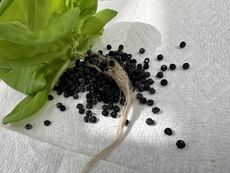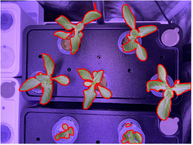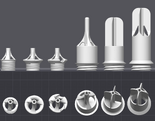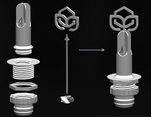Background[edit | edit source]

Lyrata Inc. was founded in 2021 and won the NEST Competition at the University of Toronto's Hatchery Entrepreneurship program. I wasn't part of it to start with, but rather joined as a mechanical designer co-op student in summer 2022 and began vesting as a co-founder six months later.
The company’s primary focus was the development of a novel, 3D-printable, reusable hydroponic grow medium, termed "SmartSoil." This innovative grow medium offers a significant environmental advantage, reducing carbon emissions by 88% during its production compared to traditional hydroponic substrates. Furthermore, its 3D-printable nature allows for decentralized production, which enhances accessibility in remote regions, such as Northern Canada.
Although the growth performance of SmartSoil had been partially validated by this stage, the commercialization process faced numerous technical and business challenges. A key issue was that most hydroponic farms are designed around established commercial grow media, such as RockWool. SmartSoil was not inherently compatible with the infrastructure and operational practices of these systems, making it difficult to commercialize as a standalone product. Consequently, the integration of SmartSoil into commercial hydroponic systems required the development of a new operational framework, including infrastructure and standard operating procedures tailored specifically to the unique characteristics of this medium.
Research and Development[edit | edit source]
SmartSoil Dispenser[edit | edit source]



To ensure the commercial viability of SmartSoil, it was essential to develop a mechanism that facilitates easy handling. My investigation focused on designing a dispensing tool capable of delivering a pre-set quantity of SmartSoil in a single motion. Ideally, this tool should also be adaptable for future automation to accommodate scalability in commercial operations.
While existing tools, such as candy or fish food dispensers, served as initial references, they proved inadequate for SmartSoil due to its unique properties. Unlike fish food, SmartSoil pellets are solid and very hard to break apart when it is blocking the motion. Furthermore, dispensing them individually, as one would with candy, was impractical as well since each operation required dispensing 12-16 pellets simultaneously. The rough surface of the pellets often caused jamming, which further complicated the dispensing process.
The general concept, illustrated in the figure "SmartSoil Dispensing Motion Draw-up," involves segmenting a pre-set volume of pellets and releasing them through an opening at the bottom. The challenge lay in segmenting the volume without causing jams during the transition from step 2 to step 3, as depicted in the figure. To find a suitable segmenting tool (depicted by the blue line in the "SmartSoil Dispensing Motion Draw-up"), I conducted multiple feasibility tests using various materials, including paper, plastic sheets, brushes, and 3D-printed shovel-like components, none of which worked consistently without jamming, especially in corners where the rough surface of the PLA pellets can cause obstructions.
The breakthrough came when I reconsidered the role of jamming itself. Rather than attempting to avoid jams entirely, I explored the possibility of leveraging the inconsistent movement of the segmentation tool to manage jamming scenarios. By allowing some flexibility in the travel path of segmenting tools, I developed the first prototype of the SmartSoil dispenser, constructed from four 3D-printed components and two tension springs, as shown in the figure "Soil Dispenser - First Version."
The segmentation tool (orange part in "Soil Dispenser - First Version") is connected to the main body (grey part) via a tension spring, which pulls it toward the left. To operate the dispenser, the user holds the main body with one hand and uses the other hand to pull the "Under Door" (blue part) to the right (reloading) and then to the left (releasing). If SmartSoil pellets prevent the segmentation tool from returning to its default position, the system remains functional, as the jamming prevents further pellets from entering the pre-set volume, thus ensuring the operation continues without hindrance.
Testing confirmed that this design worked as intended. Following several iterations focused on improving ergonomics and efficiency, I reached the eleventh version of the SmartSoil dispenser, illustrated in the figure "Soil Dispenser - 11th Version." This version has been used by our growing team for over a year, significantly enhancing the efficiency of SmartSoil sowing operations.
Plant CV[edit | edit source]

In order to monitor plant growth and health across dispersed growing locations, there was a need for a modular and cost-effective plant computer vision (CV) system. Commercial and laboratory plant camera systems easily cost several thousand dollars, making them impractical for this application. Thus, I needed to develop an alternative solution that was both affordable and scalable.
For the hardware, I used a Raspberry Pi and a Raspberry Pi camera, which together cost less than CAD $300. While this low-cost setup had certain limitations such as reduced image quality and color inaccuracy, these issues could be mitigated by implementing calibration functions.



To address color inaccuracy, I experimented with various thresholding methods and functions applied to the RGB and HSL channels of the captured images. For example,
As plants grow larger, they tend to overlap, making it challenging to accurately track the leaf area of individual plants. While the goal was to automate the segmentation process, allowing for automatic differentiation of individual leaves, this proved impractical due to the difficulty of distinguishing overlapping leaves, even manually. Consequently, a compromise was made by employing "hard" segmentation, wherein predefined lines are used to demarcate areas for each plant. This method, though less precise, offers a functional solution to track individual plant growth.
As part of the calibration process, a segmentation map was created for the camera’s current position, as illustrated in the leftmost section of Figure "Segmentation Map and Results." While the results were not perfectly accurate, they effectively highlighted general growth trends. This method proved sufficient for detecting abnormal growth patterns and for cross-comparison between different growing cycles.
.
.
.
.
.
.
Drainage System[edit | edit source]



In commercial hydroponic systems, drainage components typically incorporate nets or meshes to prevent leaves and roots from obstructing the flow of water. However, these components require frequent maintenance, as the accumulation of organic matter around the drains can impede water flow, causing the water levels to rise. This restriction in flow often results in reduced dissolved oxygen levels, which can lead to root suffocation. In more severe cases, if the drains become excessively blocked, water may overflow, posing a significant risk to the system. Growers are thus compelled to regularly clean the drains to maintain functionality.
To address the issue of low dissolved oxygen levels, some growers employ air pumps and air stones. While effective, these methods come with drawbacks since air pumps consume a constant supply of electricity, and air stones are difficult to clean, adding to the system’s maintenance demands. These challenges prompted me to explore simpler, more efficient methods to increase dissolved oxygen levels in hydroponic systems.
Through multiple iterations, a new drainage design was developed and tested, as shown in the attached image "Air Drainage." The concept behind this design was to create a consistent mixture of water and air within the drainage tube that connects two tiers of the system. The vertical straw-like structure at the center ensures that water cannot flow down without integrating air, thereby promoting aeration. This mixing action is visually evident from the small bubbles that form at the bottom tier around the connecting tube. By experimenting with variations in the size and length of the "straw," I was able to optimize the bubble size to achieve the desired level of dissolved oxygen. The bubbles generated were neither too small, which would be ineffective for oxygen dissolution, nor too large, which could result in splashing water onto the raft boards. This balance resulted in a more efficient aeration process that supports plant root health while minimizing maintenance.
As illustrated in the image "Air Drainage," iterations 3 to 5 featured patterns or shapes designed to induce rotational turbulence within the drainage system. This design modification increased water flow speed and enhanced the frequency of water-air collisions, thereby improving oxygenation. However, this feature also made the drainage component significantly more difficult to clean. Consequently, it was removed in the final iteration to prioritize ease of maintenance.
The final design includes four "flaps," introduced in the last two iterations, to prevent the raft boards from being lifted during operation and to improve the ease of handling when screwing the component on and off. A complete set of the drainage system, as shown in the image "Drainage Set," was successfully designed, prototyped, and validated. All of these components were optimized for 3D printing and can be printed without the need for support structures.
To mitigate the risk of dead leaves and roots entering the system and potentially obstructing the drains, a filter tool was developed, as shown in the image "Leaves Filter." The filter operates by placing a mesh between components B and C, secured in place by the ridges on piece B. Each unit requires only one filter. The filter body is designed with a wide surface area, reducing the frequency of required cleanings. Its "drawer" design also allows for easy maintenance and cleaning.
The drainage set and the leaves filter work together to ensure high levels of dissolved oxygen in the water, facilitate quick and easy removal of solid debris, and maintain a consistently high water flow rate, and minimizing the risk of overflow.
Summary[edit | edit source]


As a start-up with limited cash, we make most of our own tools and equipment in house by leveraging 3D printing and IoT technologies. Including the three tools that are shown here, I have personally developed over 60 pieces of tools and equipment at Lyrata Inc. Additionally, I have created Standard Operating Procedures (SOPs) for the growing systems, developed detailed calculation tools that integrate plant science, engineering, and sales data, and managed over 30 students in the day-to-day operations of the growing systems and our 3D printing farm.
Currently, the Lyrata SmartSoil Growing System is operational at three locations in Toronto: University of Toronto St. George, Casa Loma, and University of Toronto Scarborough.


